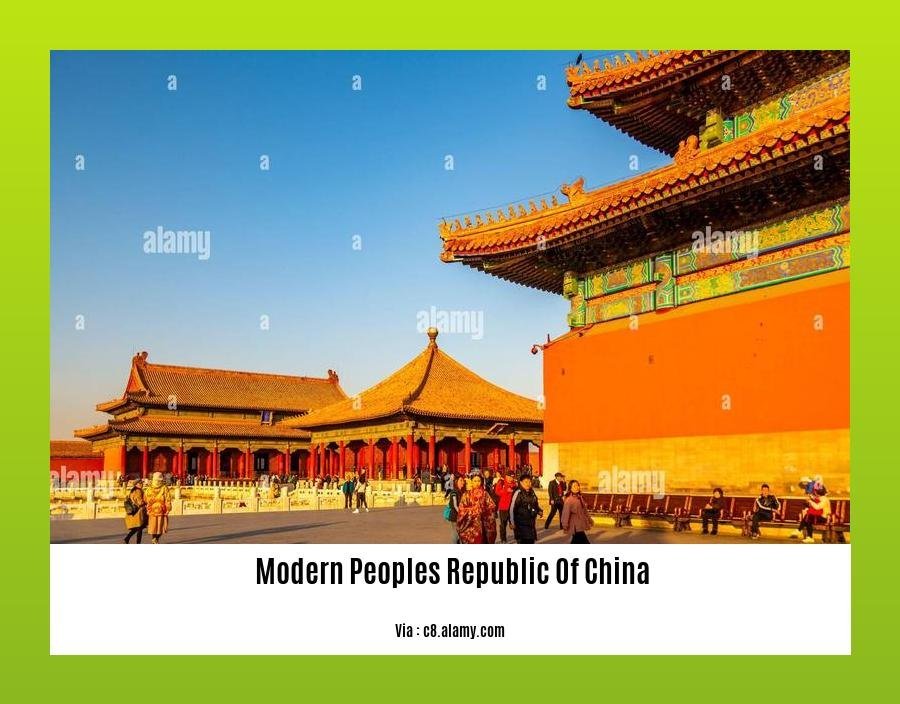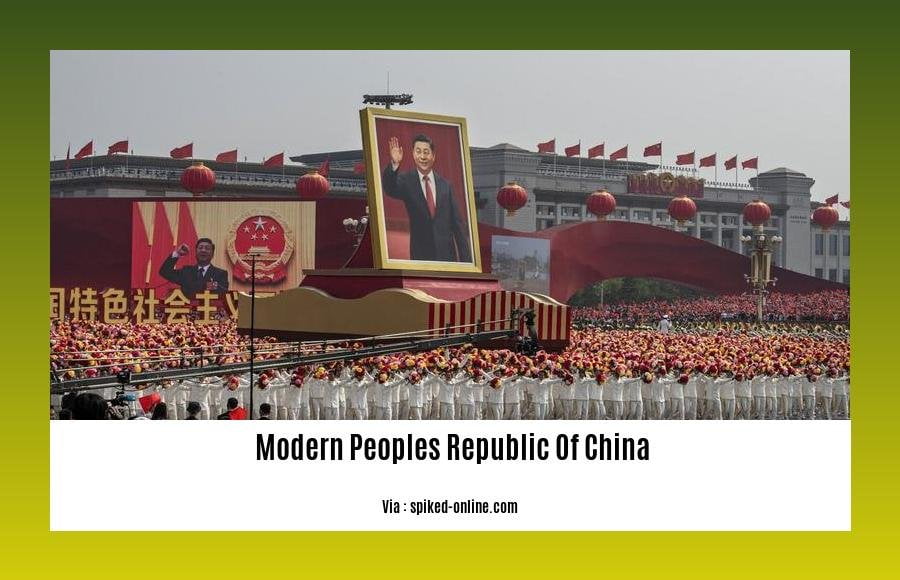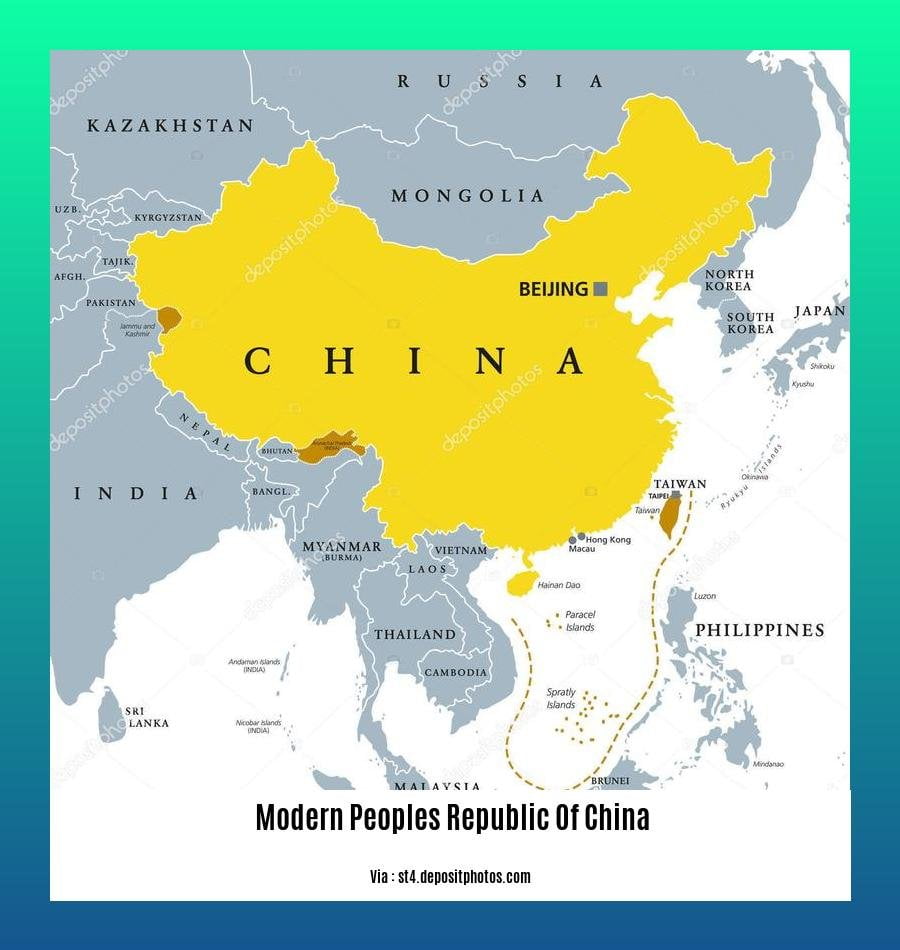Decoding the Modern People’s Republic of China: An Expert’s Perspective. Discover the intricate political, economic, and social dynamics that define the modern People’s Republic of China. Gain valuable insights into China’s foreign policy, regional influence, and its growing role in the global arena. This expert analysis provides a comprehensive understanding of China’s transformation and its impact on the world stage.
Key Takeaways:
- China, or the People’s Republic of China (PRC), is located in East Asia.
- With a population of over 1.4 billion, it’s the most populous country globally.
- China covers an extensive area of approximately 9,600,000 square kilometers, making it the third or fourth largest country.
- Beijing serves as the capital city.
- Mandarin Chinese is the primary language spoken in China.
- The official currency is the Renminbi.
- China officially declares atheism as its main religion, but traditional Chinese religion, Buddhism, Taoism, and Christianity are widely practiced.
Modern People’s Republic of China

China has emerged as a global powerhouse, shaping the world’s political, economic, and social landscape. Its rise to prominence has been marked by remarkable economic growth, technological advancements, and a growing role in international affairs. Understanding the modern People’s Republic of China is crucial to deciphering the dynamics of the contemporary world.
Political Transformation
The modern People’s Republic of China has undergone significant political transformations since its establishment in 1949. While the Chinese Communist Party (CCP) maintains its grip on power, the country has adopted a more market-oriented economy and implemented gradual reforms within its political system. The focus on stability and economic development has characterized China’s political landscape.
Economic Miracle
China’s economic growth has been nothing short of astounding. Over the past decades, it has transformed from a largely agrarian society to the world’s second-largest economy. Rapid industrialization, urbanization, and technological innovation have driven this economic engine, lifting millions of people out of poverty.
Global Influence
China’s growing economic and military might has propelled it to the forefront of global affairs. It has emerged as a major player in international organizations, such as the United Nations and the G20, and has established strategic partnerships with countries worldwide. China’s foreign policy is guided by the pursuit of peace, stability, and the promotion of its national interests.
Internal Challenges
Despite its remarkable achievements, the modern People’s Republic of China faces several internal challenges. Income inequality, environmental degradation, and the need for political reforms pose significant hurdles to continued progress. Balancing economic growth with social equity and environmental sustainability will be critical for China’s future success.
Understanding the modern People’s Republic of China is an ongoing and complex task. Its political, economic, and social dynamics are constantly evolving, and its role in the global arena continues to expand. By staying abreast of the latest developments and seeking informed perspectives, we can better grasp the complexities of this modern superpower and its impact on the world stage.
Delve into the history of China, a tapestry of ancient dynasties and the rise of Imperial China.
Foreign Policy and Diplomacy

China’s foreign policy has undergone significant shifts in recent years. While maintaining its commitment to non-interventionism, China has also expanded its global ambitions. This shift reflects China’s growing economic clout and its desire to play a more prominent role in international affairs.
Key Takeaways:
- Ambitions: Expanding foreign policy ambitions, particularly in the East China Sea.
- Economic Integration: Investing heavily in global infrastructure to promote economic integration.
- Non-Interventionism: Emphasizing non-interventionism, respecting the sovereignty of other nations.
- Long-Term Goals: Prioritizing safeguarding independence, sovereignty, and fostering a favorable international environment for modernization.
- South-South Cooperation: Valuing relationships with developing countries in the Global South.
- Wolf Warrior Diplomacy: Adopting a more aggressive diplomatic style under Xi Jinping.
Economic Integration
China has become increasingly integrated into the global economy. Its massive Belt and Road Initiative (BRI) aims to connect China to other countries through infrastructure projects. This initiative has been criticized by some as a way for China to expand its influence, but it has also been welcomed by many countries as a way to boost economic growth.
Non-Interventionism
China has traditionally emphasized non-interventionism in its foreign policy. This principle reflects China’s historical experience of foreign intervention and its desire to avoid getting entangled in conflicts with other countries. However, China has also intervened in a few cases, such as in the Korean War and the Vietnam War.
Long-Term Goals
China’s foreign policy is guided by a set of long-term goals. These goals include safeguarding China’s independence and sovereignty, promoting economic development, and creating a favorable international environment for China’s modernization. China’s leaders believe that these goals can be achieved through a combination of diplomacy, economic cooperation, and military strength.
South-South Cooperation
China has placed a high priority on developing relationships with other developing countries in the Global South. This cooperation has taken a variety of forms, including economic aid, trade, and technical assistance. China’s goal is to build a coalition of developing countries that can counterbalance the influence of the United States and other Western powers.
Wolf Warrior Diplomacy
Under Xi Jinping, China has adopted a more aggressive diplomatic style known as “Wolf Warrior Diplomacy.” This style is characterized by a willingness to confront other countries, even major powers like the United States. Wolf Warrior Diplomacy has been criticized by some as being counterproductive, but it has also been praised by others as a necessary response to the West’s attempts to contain China.
Citations:
Foreign Policy of China
Wolf Warrior Diplomacy
Social and Cultural Transformation
China’s social and cultural transformation is a fascinating story of modernity intertwining with tradition. Imagine a society where ancient rituals coexist with skyscrapers.
As China’s cities expanded, the Zhou civilization’s influence spread, assimilating diverse populations. Over time, China has embraced foreign cultures, adding vibrancy to its heritage.
This transformation is a dance between tradition and modernity. Rural villages blend with bustling metropolises, as people navigate a world that’s both familiar and foreign. It’s a journey of constant evolution, where the past shapes the future and the future reshapes the past.
Key Takeaways:
- China’s social and cultural transformation has accompanied its modernization journey.
- Urbanization has been a catalyst for the assimilation of non-Zhou populations into Zhou civilization.
- China has become more receptive to foreign cultures in modern times.
- Modernization in China involves a dialectic between tradition and modernity.
References
– China – Cultural, Political, Social Changes
– Changing China: Cultural Transformation Throughout the Years
Challenges and Opportunities
The challenges facing modern China are complex and manifold.
Challenges
Persistent employment insecurity plagues the nation, with economic growth failing to keep pace with the demands of a rapidly expanding workforce. Growing inequality has become an acute concern, with the gap between the wealthy and the poor widening at an alarming rate.
Opportunities
Despite these difficulties, China also presents a wealth of opportunities. Economic reforms have created new avenues for people to improve their livelihoods, and a rapidly expanding middle class is fueling consumer demand.
Key Takeaways:
- China faces a range of Challenges and Opportunities in the modern era.
- Challenges include employment insecurity, growing inequality, and an ageing population.
- Opportunities arise from economic reforms, expanding infrastructure, and a growing middle class.
Citations:
- The Diplomat: China’s Core Economic Issues in 2022
- Cato Institute: China’s Future Development: Challenges and Opportunities














